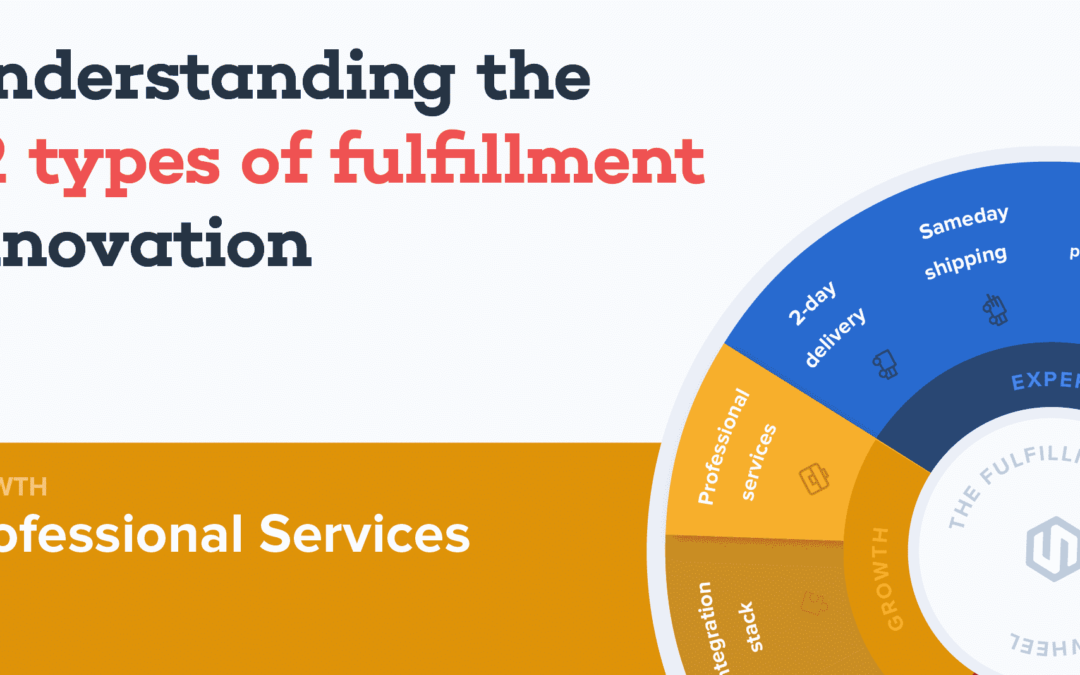
Feb 15, 2021 | Blog, The Fulfillment Innovation Wheel
ShipHero recently launched The Fulfillment Innovation Wheel to help 3PLs understand what capabilities and service offerings they need to implement in order to be successful and to help online retailers and brands choose which 3PL is right for them by allowing them to ‘check the boxes’.
The Fulfillment Innovation Wheel listed a set of twelve (12) capabilities that fulfillment providers and logistics companies should implement to continually delight their customers and push themselves towards greater success and innovation.
The twelve capabilities are:
- 2-Day Delivery
- Same Day Shipping
- At the Box Personalization
- Designed for Returns
- Sustainable Fulfillment
- Resilient Shipping
- Distributed Fulfillment
- Data Now
- Automation
- Scale Up and Out
- Integration Stack
- Professional Services
In this article, we will be diving into Capability #12: Professional services.
And be sure to stay tuned for future articles as we deep-dive into each capability.
Capability #12: Professional Services
If you want to grow your business, your Warehouse Management Software (WMS) needs to keep up by collecting and processing more data, offering users more capabilities and automation, and providing more customizable reports and integrations. As WMS grow more and more powerful with each iteration, naturally so does its complexity. That’s why business owners who want to get the most out of their WMS are turning to Professional Services offered by their fulfillment provider.
Customization
App developers try to make WMS interfaces as easy to use as possible, and often take a one-size-fits-all approach to developing their solution. When that doesn’t cut it for your business, Professional Services are the perfect way to custom-fit the solution to your exact specifications.
ShipHero customers can select a wide range of customization services that include (but are not limited to):
- Custom reports
- Custom invoices and labeling
- Custom API integrations
- And more!
Error Correction
Everyone makes mistakes! Professional Services are the easy way to get you right back on track with your WMS.
For error correction, ShipHero offers:
- Manual/Bulk Data correction
- Re-running Automation Rules
- Integration testing/debugging
- And more!
Consulting
Sometimes you just need an expert opinion. Warehouse process and development experts stand at the ready to help you figure out the tough problems.
ShipHero’s experts are available to provide:
- Warehouse Process Consulting
- API Consulting
- Onboarding Consulting
- And more!
So, does your fulfillment provider give you the attention and service that you need? Whether you need a quick fix over the phone or a more hands-on approach with our onsite visits, ShipHero helps its customers any way they can through their extensive list of Professional Service. Not only that, ShipHero maintains a community of customers that all chip in to help each other.
It’s this white-glove approach to service that brings an average of 100 new signups for our fulfillment service per day, and we attribute this success on the Fulfillment Innovation Wheel to Capability #12: Professional Services.
Stay tuned next as we cover Capability #11: Integration Stack! Integrate-ful for your business. ShipHero.
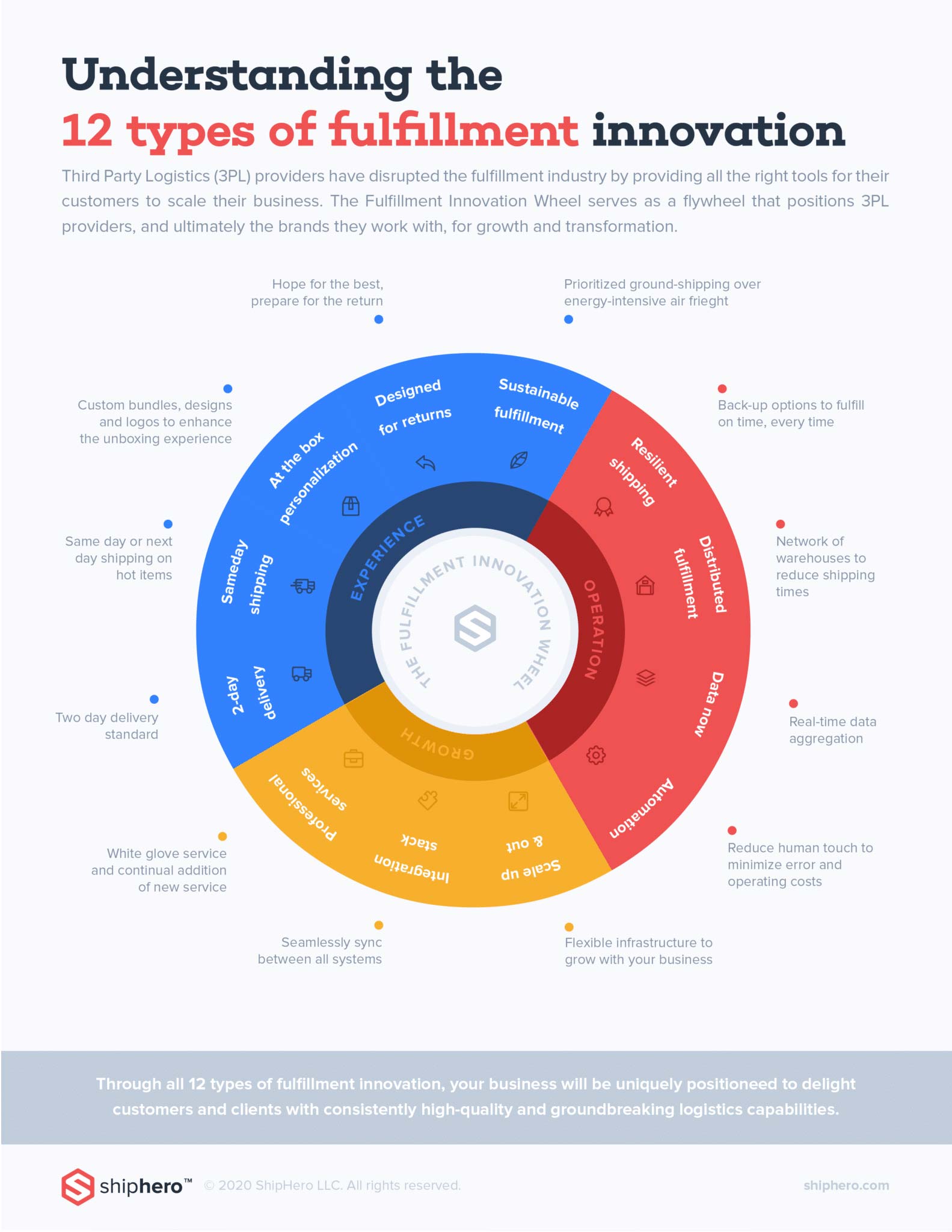
Learn more about ShipHero’s industry-leading warehouse management software.

Apr 21, 2023 | Blog
Inventory accuracy is pivotal for businesses dealing with tangible products. It encompasses the processes of monitoring, computing, and enhancing the stock levels of goods. Regardless of whether you manage a quaint boutique or a sprawling warehouse, a clear grasp of your inventory is vital for a streamlined and profitable operation. Inaccuracies in your inventory system can result in stock mismatches, delayed fulfillment, and unhappy customers.
What Is Inventory Accuracy?
Inventory accuracy is the alignment between a company’s physical stock levels and its recorded inventory data. It’s about ensuring that the actual quantity of an item in the warehouse matches the number in the company’s records. Many companies grapple with this issue, but there are strategies to boost inventory accuracy formula keep rates. Businesses employ inventory control methods like routine stock counts, the adoption of an inventory management system, and the integration of barcodes or RFID tech to monitor inventory items, SKUs, and storage bins.
Why Is Inventory Accuracy Important?
- Ensures Accurate Inventory Valuation:
Inventory accuracy plays a pivotal role in guaranteeing precise inventory valuation. This valuation is integral to a company’s financial reporting, influencing the computation of costs, profits, and net earnings. When businesses maintain accurate inventory records, they can determine their inventory’s true value, leading to more trustworthy financial statements. This accurate inventory important also offers insights into the impact of their inventory management on their financial health.
- Avoids Over or Understocking:
Excess stock or stockouts can be detrimental. While overstocking results in higher holding costs and reduced profits, stockouts can cause missed sales opportunities and dwindling customer satisfaction. Accurate inventory records empower businesses to make informed decisions about restocking, discounting, and optimizing excess inventory and space.
Dead stock is unsellable inventory, often due to overstocking, subpar inventory management, or changing customer preferences. It consumes capital, takes up space, and elevates holding costs. Proper inventory management identifies and addresses dead stock, facilitating better inventory forecasting and customer demand understanding.
Errors in inventory data can disrupt order fulfillment, causing backorders and shipping delays. This tarnishes the customer experience and brand reputation. Ensuring inventory accuracy helps businesses maintain adequate stock levels, ensuring timely order fulfillment and enhancing customer satisfaction.
Inventory Accuracy Challenges
Achieving consistent inventory accuracy is a daunting task for businesses across sectors. Common challenges include manual data entry mistakes, outdated inventory tracking tools, disorganized warehouses, inefficient restocking processes, and inadequate employee training. However, remedies like warehouse and inventory management software,, barcode or RFID tech, routine physical stock counts, better warehouse organization, and comprehensive staff training can address these issues. Embracing best practices in inventory reconciliation and understanding the nuances of accounting in inventory valuation can aid companies in upholding inventory accuracy and averting financial setbacks.
If you’re grappling with these challenges, ShipHero is here to assist. Our warehousing and fulfillment solutions offer clarity and control over inventory planning and execution, leveraging best practices to minimize errors, maintain inventory accuracy and enhance inventory accuracy.
How to Calculate Inventory Accuracy rate
To determine inventory accuracy, one must compare the actual physical stock levels with the company’s recorded data. This comparison helps businesses gauge inventory inaccuracies and the reliability of their inventory records and pinpoint discrepancies. Here’s how to compute inventory accuracy:
- Choose a time frame for the calculation, be it weekly, monthly, or quarterly.
- Conduct a physical stock count during this period, ensuring it aligns with the time of updating inventory records.
- Compare the physical count with the recorded data to ascertain record accuracy. The difference between the two gives the variance.
- Use the formula: Inventory accuracy = (1 – (variance / recorded inventory)) x 100. For instance, if the documented stock count is 1,000 units and the actual count is 950 units, the variance is 20 units. Thus, the inventory accuracy is 96%, meaning the records are accurate for 96% of the stock.
- Analyze the results and address any discrepancies. This might involve adjusting records, probing the reasons for discrepancies, or introducing new inventory management strategies.
What Is a Good Inventory Accuracy Rate?
The ideal inventory accuracy rate varies based on the industry, product type, and business requirements. Generally, a rate of 95% or above is commendable. However, sectors like pharmaceuticals or electronics might demand even higher rates due to their value and regulatory standards. Regular monitoring and corrective measures can help businesses consistently enhance their accuracy rate and refine their own inventory management system.
How to Improve Inventory Accuracy
Inventory tracking inventory counting is indispensable for businesses handling tangible goods. Yet, it can be intricate, especially when dealing with vast quantities. Inventory shrinkage, the gap between recorded and actual stock levels, can adversely affect a company’s financial health. Delays, shortages, and overstocking often stem from inventory shrinkage. Pinpointing its root causes is crucial for rectifying these issues and refining inventory management.
Human error and errors, like data entry mistakes or mislabeling, are primary culprits behind inventory shrinkage. Other factors include suboptimal inventory management practices, such as insufficient tracking systems or ineffective restocking processes. Technologies like RFID and barcode scanning can mitigate these issues by minimizing manual errors and offering real-time inventory insights.
Effective inventory management, encompassing precise counting and tracking, is paramount for business success. By adopting an inventory management system, businesses can automate tracking, curtail manual inventory errors made, and gain real-time stock visibility. This not only prevents inventory shrinkage but also ensures accurate order fulfillment. Warehousing and supply chain operations also benefit from precise inventory tracking and efficient order processing.
Cycle counting is another effective strategy. It involves periodic partial stock counts throughout the year, offering a more accurate and efficient counting method compared to an annual full stock count. By adopting cycle counting, businesses can grasp their inventory reconciliation tasks better and spot discrepancies promptly. Ensuring meticulousness during cycle counting minimizes errors, ensuring up-to-date and accurate records. This method lightens the load of a full stock count, conserving time and resources. By integrating cycle and traditional physical inventory counting, in their warehouses, businesses can bolster their inventory accuracy, diminish shrinkage, and fine-tune their inventory management processes.
Key Takeaways
Inventory accuracy, while essential, comes with its set of challenges, from manual data entry blunders to inefficient restocking processes. So, how can we overcome these hurdles and boost our inventory accuracy? While hiring a psychic might be an intriguing yet costly option, a more pragmatic approach calculating inventory accuracy involves adopting inventory management software, conducting routine physical stock counts, leveraging barcode or RFID technology, enhancing warehouse organization, and offering comprehensive staff training.
So, here’s to all the meticulous inventory trackers! May your stock levels always be spot-on and your backorders a thing of the past!
Inventory Accuracy FAQs
What Causes Inventory Inaccuracy?
Several factors can compromise inventory accuracy. Manual data entry mistakes can skew inventory levels, leading to overstocking or stockouts, missed sales opportunities, and elevated holding costs. Outdated [inventory tracking systems](https://shiphero.com/blog/article/inventory-tracking/) and disorganized warehouses can exacerbate the issue of inaccurate inventory amount, causing delays in order fulfillment. Moreover, ineffective restocking processes and insufficient training can further erode inventory accuracy, impacting profitability and customer satisfaction.
What is Inventory Accuracy Percentage?
This metric gauges how closely a company’s documented stock levels align with the actual physical stock. It’s computed by contrasting the actual physical stock count with the recorded data, dividing the difference in physical inventory counting by the recorded count, and multiplying the result by 100 to get a percentage. For instance, if the documented stock count is 1,000 units and the actual count is 950 units, the inventory accuracy percentage is 95%. This indicates that the records are accurate for 95% of the stock.
What is the Average Inventory Accuracy?
The typical inventory accuracy varies based on industry, business scale, and specific inventory management practices. Research indicates that the average accuracy rate for most businesses hovers around 65%. This suggests ample room for improvement for many businesses. By embracing best practices and routinely monitoring and improving inventory accuracy, businesses can progressively enhance their accuracy rates.


Feb 16, 2023 | Blog
There are lots of moving parts in order fulfillment. You need to track the picking, packing, processing and shipping steps to ensure nothing goes wrong and keep customers happy. Unfortunately, monitoring operational processes is often time-consuming and challenging to do by yourself.
This is where third-party logistics (3PL) companies come in. Hiring a 3PL company gives you access to their expertise and 3PL software to assist in order fulfillment – resulting in cost savings. These software tools are also part of what makes 2PL, 3PL and 4PL companies different.
Which 3PL software should you use to improve your logistics operations? Read on for a list of the best 3PL software available today.
What Is Software for 3PL?
Software for 3PL is a tool that helps companies better manage their order fulfillment process and warehouse operations. 3PL software, in the third-party logistics environment, improves shipping times, drives shipping costs down, manages retail distribution, provides real-time inventory visibility and does other order fulfillment tasks to ensure you operate at maximum efficiency.
3PL software can also integrate with the client’s systems, so everything gets updated simultaneously. This eliminates double data entries and inconsistencies between records, which prevents costly mistakes.
Benefits of Third-Party Logistics Software
3PL software helps you better manage the order fulfillment and logistics process through automation and data management. Here are five ways 3PL software benefits your company:
Reduce Operational Costs and Save Time
3PL software automates various manual processes like invoice generation, inventory management, data entry and order tracking. Since computers work faster than humans, you’ll save time. Moreover, you’ll also reduce operational costs and save money because you don’t have to hire additional people to perform these tasks.
Prevent Human Error
Data entry is a repetitive and time-consuming job prone to mistakes, especially if the information is passed around multiple teams before it goes into the database. Third-party logistics providers use 3PL software to automate data entry and other error-prone business processes, reducing potential costly mistakes.
Make Better Decisions
Third-party logistics companies use 3PL software to record data and create reports on things like inventory, staff performance and other essential information. These reports are compiled from real-time data, so managers can make informed decisions based on current circumstances.
Promote Sustainability
3PL software plays a large role in creating sustainable third-party logistics and supply chain processes. One of the features of 3PL software is transportation route optimization, which means the software calculates the most efficient way to get items to customers.
Optimizing transportation routes also means your company will use less carbon-intensive transportation, like transporting items in bulk by rail instead of smaller deliveries with trucks.
How to Maximize the Benefits of Software for 3PL
Working with 3PL companies means investing time and money, which don’t come easily. If you want to maximize the benefits of 3PL software, do these three things:
- Leverage your third-party logistics service provider’s expertise. Listen to their suggestions and follow their advice regarding order fulfillment.
- Communicate with your third-party logistics business partner. Ask as many questions as needed and ensure they know about potential issues before they balloon into a bigger problem.
- Set metrics and focus on improving them. Discuss what metrics you aim to improve through the working relationship, and let the third-party logistics business partner boost those numbers instead of spending time making reports.
How to Get Started with Software for 3PL
You can get started with software for 3PL by working with a third-party logistics provider. Third-party logistics businesses usually bring their own 3PL inventory and fulfillment software to your company. If your third-party fulfillment business partner doesn’t have a preferred software, talk with its representative about which software to implement.
What Features Should You Look For in Software for 3PL?
Different 3PL software offers different features, but some essential things should be in all 3PL software tools. Here are several must-have 3PL-centric features in a third-party logistics software solution:
- User-friendly interface
- Cloud-based storage and functionality
- Real-time order and shipment tracking
- Strong integrations with online retail and accounting solutions
- Transport route optimization
- Multi-account support
- Automated invoicing and reporting
Your 3PL software should also be scalable and able to keep up with fast-growing businesses to ensure it can still support your company as it grows. Excellent and helpful customer service is also a big plus point since you may need them if the software solution encounters an error.
How Much Does Software for 3PL Cost?
Software for 3PL costs differently depending on the provider. Most third-party fulfillment companies fold the software costs with their service fees, so you need to ask each company about their prices.
Best Software for 3PL
Numerous 3PL providers and software are available today, each with different service offerings and benefits. Here are five of the best 3PL software solution providers available in the logistics industry:
ShipHero is a third-party logistics and order fulfillment solution provider that integrates with your online storefronts and gets products to customers faster at flat-rate fees. It operates eight distribution centers across North America to ensure maximum reach and minimum carbon footprint from air deliveries.
Its 3PL software provides a complete suite of features, including order processing, inventory management, reporting and so much more. Ultimately, it helps your company process more orders faster, boosting customer satisfaction and cutting down on logistics costs.
Trimble is transportation management software created to boost efficiency and reduce costly administrative mistakes. This software offers a real-time shipping tracker, ensuring you know where your products are and when they’ll arrive at the customer’s doorstep.
Trimble also offers a flexible third-party logistic solution, meaning you can request changes in the software to support your business operations. For instance, it allows you to install Trimble on either the SQL or IBM i platform to fit your business needs.
Fishbowl is an enterprise solution that provides real-time visibility into your warehousing operations. It’s great for managing inventory across multiple warehouses and fulfillment centers since Fishbowl lets you track stock across your company in real-time, no matter where the items are.
Fishbowl also integrates with popular eCommerce and accounting software like Shopify and QuickBooks Enterprise, so you don’t have to input information twice.
This WMS from Camelot Software supports cloud-based and on-premise deployment, meaning you have more flexibility in deploying your third-party fulfillment software. Excalibur serves various warehouse types, such as regular warehouses, refrigerated storage and even hazardous material warehouses.
Another great feature of Excalibur is its job scheduler tool, which creates work schedules and sends them to managers. This saves them time on having to create schedules themselves.
Syntelic is a trucking and logistics software tool boasting customizable interfaces according to your business requirements. It primarily caters to trucking companies with its robust route planning, load planning and real-time shipment update features, but it’s also useful for 3PL companies thanks to its customizability.
What Software for 3PL Does Your Business Need?
What 3PL software your business needs depends on your requirements. While most 3PL software deals with order fulfillment, you may need specialized software for other aspects of the business, such as if you want to improve your company’s transportation efforts.
Your best bet is to research all the third-party fulfillment software options available, then narrow them down to a couple of possible candidates. From there, talk with company representatives and learn whether the software caters to your needs.
Key Takeaways
3PL software goes hand-in-hand with third-party logistics companies because it assists them in managing your order fulfillment and warehousing process. Some 3PL companies bring their own software, but others may let you choose 3PL software yourself.
When choosing 3PL software, take the time to learn what your company needs and ensure that the software tool’s features fit your business.
Software for 3PL FAQs
What software do warehouses use?
Warehouses use software called a warehouse management system (WMS). A warehouse management system is software that gives companies visibility into their inventory and manages order fulfillment operations, ensuring products arrive at the customers’ door on time.
What is SAP for Logistics?
SAP for Logistics is software from enterprise resource planning provider SAP. It gathers all your logistics data from multiple databases and places it into a centralized repository, which helps eliminate discrepancies and inconsistencies.
What is a 3PL platform?
A 3PL platform or software is a program that helps 3PL companies do their jobs. It usually offers route optimization, data management and performance reporting, among other features.

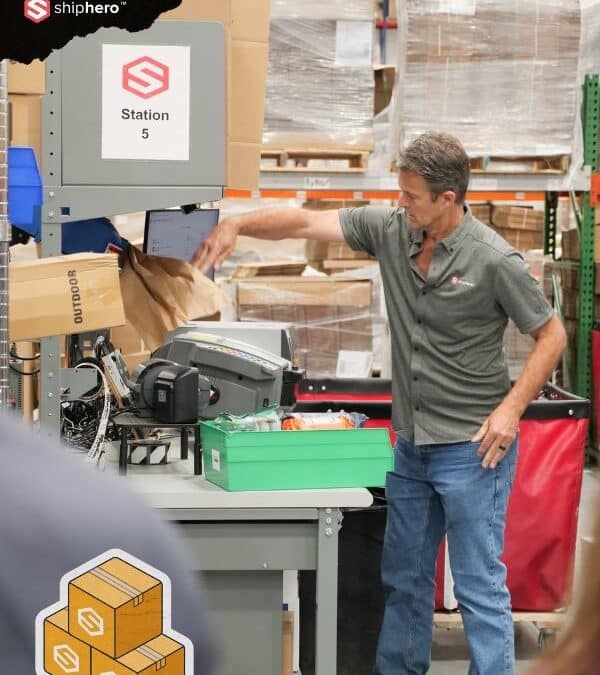
Apr 2, 2024 | Blog, eCommerce, Warehouse Management Software
For an eCommerce business, managing inventory can sometimes feel like a never-ending puzzle. As products fly off the digital shelves and new ones are added constantly, keeping track of stock levels, shipments, and order fulfillment can become overwhelming. That’s where eCommerce inventory management software is helpful.
In this article, we’ll explore the best options available to streamline your inventory management processes and help your eCommerce business thrive.
Top eCommerce Inventory Management Software
The best eCommerce inventory management software options available include:
- Software A: Known for its user-friendly interface and robust inventory tracking features.
- Software B: Offers seamless integrations with popular eCommerce platforms and marketplaces for effortless inventory management.
- Software C: Excels in multi-channel inventory synchronization, allowing businesses to effortlessly manage inventory across different sales channels.
- Software D: Provides advanced reporting and analytics tools to gain valuable insights into sales trends and inventory performance.
Each software option caters to different business needs, so it’s essential to evaluate your specific requirements before making a decision — and your evaluation process will be more successful the more you understand about eCommerce inventory management software. Keep reading to get informed.
What is eCommerce Inventory Management Software?
eCommerce inventory management software is a digital tool designed to assist online retailers in efficiently managing and tracking their inventory. These software solutions provide a centralized platform where business owners can monitor stock levels, suppliers, purchase orders, and sales data. By automating essential inventory tasks, eCommerce inventory management software gives businesses real-time help preventing stockouts and overstocks.
Automating your order management process is another way to streamline your operations further. Discover how e-commerce order management software can complement your inventory management system, ensuring seamless integration and enhanced efficiency across your sales channels.
Efficient inventory management is crucial for the success of any eCommerce business. Without it, businesses could find themselves with dissatisfied customers, lost sales, and increased costs.
eCommerce inventory management software offers comprehensive prevention measures. It allows businesses to streamline their inventory management processes so they always have the right products in stock, at the right time, and in the right quantities. With real-time insights into stock levels and sales data, business owners can make informed decisions about purchasing, pricing, and promotions.
A key feature of eCommerce inventory management software is its ability to automate various inventory-related tasks. For example, it can automatically update stock levels as orders are processed, generate purchase orders when inventory reaches a certain threshold, and sync inventory data across multiple sales channels. This automation saves time and reduces the risk of human error.
Moreover, eCommerce inventory management software provides businesses with a centralized platform where they can manage their suppliers and track their performance. This lets businesses maintain strong relationships with their suppliers, with timely deliveries and competitive pricing. Also, with a clear overview of supplier performance in their back pockets, businesses can have more information going into new contract negotiations.
Another advantage of eCommerce inventory management software is its ability to integrate with other business systems like accounting software and customer relationship management (CRM) tools. This integration gives businesses a holistic view of their operations, from inventory management to financials and customer interactions. By having all this information in one place, businesses can gain deeper insights into their overall performance and identify areas for improvement.
Furthermore, eCommerce inventory management software often comes with advanced reporting and analytics capabilities to generate customized reports, track key performance indicators (KPIs), and identify trends and patterns in their inventory data. By analyzing this data, businesses can find cost savings and improve efficiencies at all levels of the business.
In conclusion, eCommerce inventory management software is a powerful tool that helps online retailers efficiently manage and track their inventory. With its automation capabilities, real-time insights, and integration with other business systems, it helps businesses improve their bottom lines.
To dive deeper into the world of inventory management and explore the top contenders, check out our detailed overview of the best inventory management software. This guide offers insights into each option’s unique strengths, helping you understand which software might be the perfect fit for your business needs.
Benefits of eCommerce Inventory Management Software
Implementing eCommerce inventory management software brings several benefits to your business.
- It optimizes inventory levels, which reduces costs associated with excess stock or missed sales due to stockouts.
- It improves order accuracy and fulfillment speed, leading to happier customers.
- It strengthens relationships with vendors by ensuring timely deliveries.
- It aids in forecasting, making purchasing decisions, and analyzing sales trends.
For businesses that operate within a third-party logistics framework, understanding how a WMS integrates into this model is crucial. Learn more about the specifics of a 3PL warehouse management system and how it can revolutionize your logistics operations.
Common Challenges of eCommerce Inventory Management
Before delving into the best eCommerce inventory management software options, let’s examine some of the common challenges online retailers face in this area.
A frequent obstacle is inaccurate or outdated stock information, which can lead to frustrating customer experiences and lost sales.
Other challenges include managing multiple sales channels, maintaining consistent stock levels across different platforms, and effectively handling returns and exchanges. These difficulties highlight the importance of an integrated inventory management system.
Key Features of eCommerce Inventory Management Software
Each eCommerce inventory management software comes with a unique set of features to address the specific needs of online retailers. Some key features to consider when choosing the best software for your business include:
- Real-time inventory tracking and stock level alerts
- Automated purchase orders and supplier management
- Integration with popular eCommerce platforms and marketplaces
- Multi-channel inventory synchronization
- Barcode scanning and label printing capabilities
- Advanced reporting and analytics tools
- Forecasting and demand planning functionalities
How to Choose the Best eCommerce Inventory Management Software Solution
Selecting the right eCommerce inventory management software solution for your business requires careful consideration. Follow these steps to guide your decision making:
- Evaluate your business needs: Assess your inventory management pain points and identify the features and functionalities you require.
- Research the options: Explore the top eCommerce inventory management software solutions available in the market and compare their features.
- Read reviews and testimonials: Gain insights from other businesses that have implemented the software. Pay attention to their experiences and whether the software meets their needs.
- Request demos and trials: Take advantage of free trials or demos to test drive the software and assess its usability.
- Consider scalability: Ensure the software can accommodate your business growth and handle increased sales volumes.
By following these steps, you’ll be well-equipped to make an educated decision and select the best eCommerce inventory management software for your business.
eCommerce Inventory Management Software Costs
The cost of eCommerce inventory management software can vary depending on its features and functionality, as well as the size and needs of your business. Some software providers charge a monthly subscription fee, while others offer tiered pricing based on the number of orders or users.
It’s important to consider the software’s return on investment and how it aligns with your budget. Remember, investing in the right software can lead to significant cost savings and improved efficiency in the long run.
Key Takeaways
Efficient inventory management is a crucial component of a successful eCommerce business. Implementing eCommerce inventory management software can help streamline your operations, prevent stockouts, and optimize your inventory levels. By carefully considering your business needs and exploring the top software options available, you can select the best solution to propel your eCommerce business forward.

Frequently Asked Questions
Can eCommerce inventory management software integrate with multiple sales channels?
Yes, many eCommerce inventory management software solutions offer multi-channel synchronization to manage inventory across various platforms seamlessly.
How does eCommerce inventory management software help prevent stockouts?
eCommerce inventory management software provides real-time tracking of inventory levels and sends alerts when stock levels are low.
Can eCommerce inventory management software generate detailed reports?
Absolutely! Many software options come with robust reporting and analytics tools, enabling businesses to gain valuable insights into sales trends, stock performance, and more.
Is eCommerce inventory management software suitable for small businesses?
Yes, eCommerce inventory management software caters to businesses of all sizes. Many providers offer different pricing plans to accommodate the needs and budgets of small businesses.
With the right eCommerce inventory management software by your side, you can wave goodbye to inventory management headaches and focus on growing your business and satisfying your customers.

Jan 17, 2019 | Best Practices, Blog, Warehouse Management Software
The world of ecommerce is a fickle one. At times, it seems completely random which sites survive, and which do not. In reality, however, it is the sites that plan ahead and take steps to keep up with the growth of their business that are the most likely to succeed.
The primary goal of any business is to grow, though there are certainly smaller goals you want to meet along the way. In the very beginning, for example, your first goal might be to break even – to start seeing positive cash flow after covering startup costs. From there, you want to see steady growth on a month-to-month basis and over the course of the year.
Ecommerce sales totaled $1.3 trillion in 2014 and are expected to grow by nearly 250% to a total of $4.5 trillion by 2021. If you hope to capture a slice of that pie for yourself, you need to set a strong foundation, build momentum, and prepare for future challenges. In this article, we’ll go into depth about the best ways to scale your ecommerce business both efficiently and effectively.
Start Strong with a Firm Foundation
Though most ecommerce businesses start out small, you should always be thinking and planning ahead. With each business decision you make, ask yourself, “Is this strategy scalable?” This is particularly important when it comes to things like choosing your inventory and with creating and implementing a digital marketing strategy.
Here are some other tips to follow in the early days of your ecommerce business to ensure that you have a solid foundation on which to build:
- Set goals for 1, 3, 5, and 10 years. As your shop grows, you’ll find yourself making decisions that will impact the future of your business – having specific goals set at different intervals can act as a guide to help you make the decision that is best for your business.
- Determine how you will measure your company’s progress. Annual revenue is a good measure of sales, but it doesn’t reflect profit or progress. Take the time to identify your Key Performance Indicators (KPIs) so you can track your business’s progress month-over-month and evaluate how different growth strategies pan out.
- Write a solid business plan. You’ll need a business plan in order to guide the success of the business within the first year. This plan is not only key for starting any new business but also projecting what hurdles you’ll have to overcome in the future as well as keeping you accountable.
- Run the numbers before you commit. Before you start buying or manufacturing inventory, you need to know that your sales will be enough to cover your costs. Create a cash flow spreadsheet and run the numbers to see how much revenue you can expect, what your monthly fixed costs will be, how much you’ll be spending on inventory, etc.
- Identify your target audience and build your brand. Gather information about your demographic and develop your brand to appeal to that audience. Having a strong brand identity will help guide you in future endeavors such as implementing a digital marketing strategy and choosing where to expand in the future.
- Build a strong website. Your website is going to be the mode that drives your sales, but it is also a tool for driving traffic. In addition to creating your sales pages and landing pages for any outbound marketing, you’ll also need content to help drive search engine traffic (inbound marketing).
First Steps to Build and Retain Momentum

Building your initial website can end up being easier than you might think. Particularly with the multitude of tools at your fingertips, such as Shopify. What is not so easy is turning that website into a successful, profitable, and scalable business. Though annual worldwide ecommerce sales are in the trillions, many new shops close their doors within the first few years. In order to scale your business for long-term growth, you’ll need to start out by taking certain steps to build and retain momentum. Here are 3 things you need to do:
1. Create a Strong Digital Marketing Campaign
Your website is the infrastructure for your online business, but you’ll never make any sales if no one sees your page. A strong digital marketing campaign is the key to building your online presence, driving traffic to your site, and converting visitors into paying customers. Here are some simple online marketing tips to get you started:
- Do some keyword research. Before you start marketing, you need to do some research to identify the strongest keywords to reach your target audience. Ubersuggest is a great free tool that can help guide your research.
- Create an automated email campaign. Not only is email one of the easiest ways to communicate with customers, it also provides ecommerce businesses with the highest return on investment. According to a study by Campaign Monitor, for every dollar spent on email marketing $44 is made in return.
- Personalize it. The internet is continually becoming a dynamic place where it reacts to our actions. For example, the ads you see on your social feeds from websites you just visited. Make your ecommerce store a personal experience for customers and they’ll be more likely to convert. This can be as simple as adding a “click to chat” bubble on the homepage or as advanced as sending them a reminder email when they leave something in their shopping cart.
- Implement a loyalty program. Depending on what industry you’re in, acquiring a new customer is anywhere from 5 to 25 times more expensive than retaining an existing one. Consider implementing a loyalty program to keep your customers engaged and give them a reason to shop with you again.
- Optimize your site for mobile devices. You may not be surprised to learn that mobile internet traffic has outpaced desktop traffic. However, what is surprising is the fact that the search results for the same queries on mobile versus desktop searches are often different. This comes down to whether your website is mobile optimized or not. Get the upper hand for your ecommerce business in the search results by making sure your website is optimized for all mobile devices (phones, tablets, etc).
- Create content and build authority. One of the best ways to build trust with your customers is to establish your business as an authority in the industry. You can build trust by offering high-quality, informative, and relevant content on your site. Don’t limit yourself to print content either, use photos and videos as well. The process of using content to market your business is called Content Marketing.
- Connect with your target audience. The power in digital marketing comes from being able to connect with your target audience in a more personal way. No other form of marketing does this better than social media. Social channels like Facebook, Instagram, and Twitter give you the ability to connect, engage, and grow your business in a more personalized matter. Whether you’re simply building a following on social channels or using their ad platforms to connect with your demographic, you should invest time and energy into your social media strategy.
When it comes to ecommerce, digital marketing is not a one-and-done strategy – you’ll need to keep at it if you want your business to grow. There is no harm in starting out small but, as your business grows, you’ll want to start expanding your marketing strategy with it.
2. Switch to Third-Party Logistics (3PL)
In the early stages of your business, you might be able to handle order fulfillment yourself or with a limited staff. As you start scaling your business, however, you’ll need to decide whether you want to invest in your own warehouse space or if you want to outsource the order fulfillment process to a 3PL provider.
A 3PL is a third-party logistics provider who takes over one, some, or all of the aspects of your order fulfillment processes. Hiring a 3PL means that you will no longer be responsible for storing your inventory, picking and packing your orders, arranging shipment with different carriers, and handling returns. This will free you up to focus on the other things that will help you scale your business.
If you do choose to run your own warehouse, it is critical to choose the right warehouse management software.
3. Develop Excellent Customer Service
When it comes to running a successful ecommerce business, the quality of your product matters greatly. What matters even more, however, is customer satisfaction. When it comes to the scalability of an ecommerce business, word of mouth marketing is gold. This all comes down to the ecommerce buying cycle. The buying cycle looks like this:
Since ecommerce products are not tangible, like they are in brick-and-mortar retail stores, the cycle is often time more drawn out. Consumers spend more time making a buying decision because they cannot see the product in person and because there are some many choices available to them. The way you can tackle both of these obstacles is by offering customers supreme customer service.
Take for example Zappos, the world’s biggest online shoe store. In 1999, before ecommerce really became mainstream, they were able to convince people to buy shoes online. How? Through incredible customer service. In fact, Zappos encourages their customer support team to make a connection with all customers. To put this in perspective, their longest customer support call clocked in at a whopping 10 hours and 51 minutes.
Every business is unique, so the steps you need to take to build your initial momentum may be different than the steps another company needs to take. Keep reading to learn some simple ways to start scaling your business in order to retain that momentum.
6 Ways to Scale Your Ecommerce Business

As we mentioned in the beginning, building and implementing a strong digital marketing campaign is the best way to establish an online presence and to start obtaining customers. As your business grows, you’ll need to think about logistics and how best to maximize efficiency while minimizing costs.
Here are a 5 ways to do it:
- Evolve your marketing strategy. Over time, your business is going to grow and with that growth comes change. Upon achieving certain milestones, you should take a closer look at your current customer base and check to make sure that your marketing strategy is finely tuned to targeted that audience.
- Optimize your order fulfillment strategy. Whether you’re filling orders in-house or you’ve hired a 3PL, make sure that your order fulfillment strategy is designed for cost-effectiveness as well as efficiency. If you do have a 3PL partner, set aside time each year to talk to them about things such as your growth and how they can work to help.
- Consider expanding into a new market. If you are already working with a 3PL, expanding to new markets could be a fairly straightforward process.
- Upgrade your technology. As your business grows, that could mean potentially hundreds, if not thousands, of new SKUs. Your initial ecommerce platform might not cut it at a certain point. Invest in technology that helps automate your business — whether that means upgrading from SquareSpace to Magento or simply finding a new project management app.
- Keep an eye on your competitors. One of the best ways to scale your business is to fill a niche that your competitors have left open. Study your competition to understand what they’re doing right and, more importantly, what they’re doing wrong. Look for unmet needs by reading their customer reviews to get a sense of how you can fill in the gaps they’re missing.
Don’t feel like you have to implement all of these ideas at once. In fact, some of the ideas on this list might not work for your business at all. It is your job to know your business and to understand its potential – only you can decide how best to achieve your long-term goals and what tools and strategies to use along the way.
There are no guarantees in the world of ecommerce – a business that is thriving one day could tank the next. Though you cannot possibly predict every little thing that could affect your business, it pays to be thorough in the planning process if you hope to scale your operations down the road. Think carefully about building a strong foundation to create momentum in the early days of your business and always keep working to maintain that forward progress. Good luck!
ShipHero is one of the top providers of warehouse management software for ecommerce companies. See how we can help you here.
Sep 14, 2023 | Blog
Third-party logistics (3PL) is one of the ways that a company can outsource order fulfillment. An eCommerce order fulfillment process starts when a customer submits the order and finishes when the product reaches their door.
What seems like a simple process can become quite complex depending on the storage location of your company’s inventory, the customer’s location, the size of the order, and the timetable for delivery. It becomes even more complicated when you factor in the potential for returns.
Suppose you can’t handle your eCommerce fulfillment in-house. In that case, it’s probably time to outsource and let a third-party logistics (3PL) company take over.
Here’s a breakdown of what you can look forward to while reading ShipHero’s Guide to 3PLs:
Give a listen: Our newest podcast, PalletSide Chat has a few episodes that directly cover 3PLs. Take a listen here!
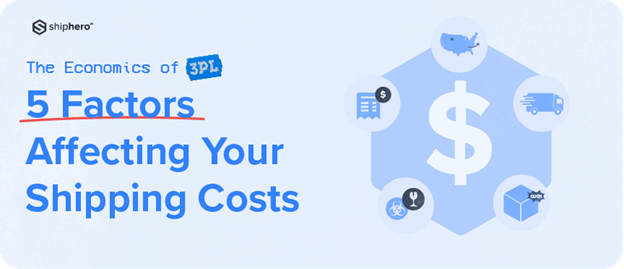
Jul 7, 2023 | 3PL Warehouse Management, Blog, Economics of 3PL, Fulfillment
Are your outbound shipping costs eating your 3PL’s profits? Today, we will cover five critical factors affecting your shipping costs and provide actionable tips to help you reduce them. We’ll give insights on everything from delivery speed to special handling fees to ensure you make operational decisions that save time and money.
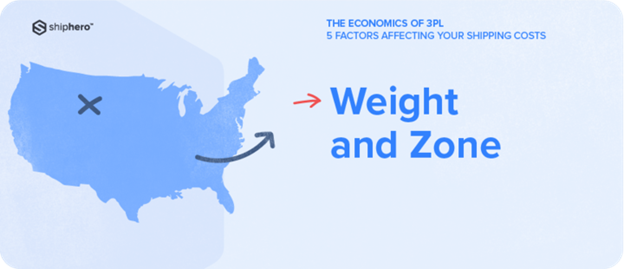
Factor 1 | Weight and Zone
For products shipped domestically within the US, two key factors come into play: the destination zone and the package’s weight.
Zone
Carriers have established nine zones across the US, with the origin address as Zone 1. Your shipping fees increase as your package moves further from its origin. Here are the current zones with their mileage differences from the source.
- Zone 1: 1-50 miles
- Zone 2: 51-150 miles
- Zone 3: 151-300 miles
- Zone 4: 301-600 miles
- Zone 5: 601-1000 miles
- Zone 6: 1001-1400 miles
- Zone 7: 1401-1800 miles
- Zone 8: 1801 miles or greater
- Zone 9: US territories & APO or FPO addresses
Weight
When it comes to shipping packages, weight matters, it’s a simple concept: the heavier the package, the more you’ll have to pay to get it where it needs to go. But it’s not just about weight; the package’s dimensions also play a significant role.
It’s a tricky balance – you want your package to be the right size to hold your products but not so large that it triggers DIM weight surcharges. Investing in a packaging design strategy is worth the time to determine the optimal package size and weight to avoid unnecessary expenses. It’s a small step that can significantly impact your bottom line.

Shipping Calculators by Carrier:
International
If you’re not taking advantage of duty relief programs for international shipping, you’re leaving money on the table. The numbers don’t lie – Section 321 alone can save you up to 20% on duty fees, and that’s a significant amount. So, what exactly is Section 321 all about?
Section 321 of the Trade Facilitation and Trade Enforcement Act has revolutionized the eCommerce shipping costs for shippers from Canada or Mexico sending goods into the U.S. to individual customers. With tax and duty exemptions, faster clearance, and reduced paperwork, shippers have remarkable advantages at their fingertips.
Section 321’s duty-free entry for goods valued at $800 USD per person per day is a smart way for businesses to grow, as it offers savings for brands looking to get their items to American consumers. While certain products are restricted, these regulations should not deter businesses from enjoying the benefits Section 321 can bring.
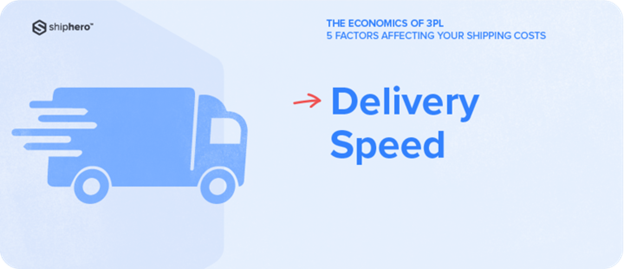
Factor 2 | Delivery Speed
The persistent and aggressive growth in eCommerce demands a seamless process to satisfy customers’ needs, and delivery speed is an essential aspect of any business that hopes to keep up with customer demands in today’s marketplace.
Margin integrity is crucial if you want to stay profitable. At ShipHero, we understand that maintaining a delicate balance between cost and delivery speed is essential for our margins to remain healthy. It hasn’t been an easy process, and we’ve made our fair share of mistakes.
Nevertheless, we’ve learned that customers expect two-day delivery from Amazon but are generally willing to wait three to four days for other businesses. However, specific expectations, such as real-time tracking, still need to be met.
90% of customers want immediate updates and real-time order visibility. Adopting technological solutions can improve delivery experiences and lower consumer inquiries.
32% of global shoppers will abandon their carts if an estimated shipping time is too long. Rising standards are forcing 3PLs and carriers to reevaluate traditional distribution models.
Fulfillment Trends
Get ahead of the trend by utilizing micro-fulfillment centers (MCFs) to cut delivery times. MCFs are strategically placed in urban areas and stocked with popular products, making it easy for customers to pick up their online orders. This gives shippers the flexibility to meet rising consumer expectations promptly.
Although setting up these local centers can be challenging and pricey, it pays off in the long run by reducing shipping costs and providing an efficient and cost-effective service. Leading 3PL companies are already reaping the benefits of this strategy and improving their overall performance.
Last Mile Delivery
Last-mile delivery accounts for 53% of the total shipping cost, and 3PLs simply can’t afford to miss the mark here. The final stage of the delivery process is where customer satisfaction and profitability are either made or broken. Unfortunately, too many managers responsible for supply chain and digital functions face significant challenges in this crucial area.
But fear not; there are solutions. By partnering with the right players, businesses can meet and exceed their customers’ expectations while boosting their bottom line. That’s why we offer Veho’s efficient and cost-effective last-mile delivery solutions.
By prioritizing necessary orders and reducing failed deliveries, Veho can make money while delivering the high level of service customers deserve while saving your 3PL money on last-mile delivery.
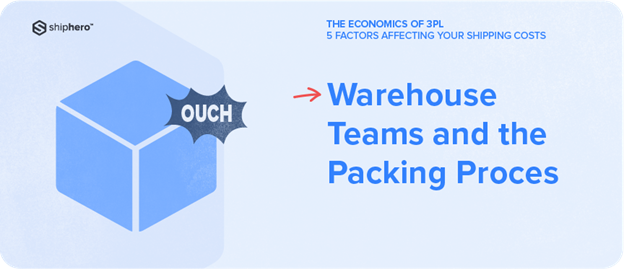
Factor 3 | Warehouse Teams and the Packing Process
When it comes to the efficiency of a warehouse, it’s essential to have a well-oiled team handling the packing process. After all, warehouse teams can make or break the whole operation. Here are some questions to ask yourself regarding your teams.
Are you investing in training your team?
Training is crucial for a proficient team, minimizing staff turnover, and boosting profits. It should cover SOPs, equipment handling, inventory management, customer order systems, and obtaining certification for specific tasks.
How efficient is your packing station?
Regularly assess your packing station’s efficiency to identify areas for improvement and reduce labor costs. Implement one-touch stations and focus on ergonomic design and workflow to optimize productivity and reduce errors.
Are you optimizing your picking paths?
Optimizing your picking paths might be the key to unlocking higher profit margins for your business. It’s simple – a slower picking process leads to increased picking costs, inevitably leading to higher product prices for your customers.
Are you using automation?
While a 95% to 98% order accuracy rate may seem reasonable, it still allows for a 2% margin of error or potentially even worse outcomes. These errors can result in significant financial losses for your warehouse.
Fortunately, implementing warehouse automation can reduce human error and improve inventory control. This will significantly enhance picking accuracy, bringing it closer to 100% and ultimately saving you money by reducing mistakes and mispicks.
Are you analyzing the correct data?
Measuring data is crucial to improve business operations. Knowing your warehouse’s key performance indicators (KPIs) is essential. Collecting and analyzing the correct data identifies inefficiencies and avoidable expenses. You’ll need to track everything from receiving through shipping to get a complete picture of your operations.
Here are a few KPIs to consider:
- Inventory Days of Supply: The day’s sales of inventory (DSI) is a financial ratio that indicates the average time, in days, that a company takes to turn its inventory, including goods that are a work in progress, into sales.

- Parcel Bill Accuracy: Review your parcel bill charges regularly to avoid overcharging. Request detailed bills from carriers if you spot any errors. This information can be helpful when renewing shipping contracts.
- Receiving Efficiency: This metric determines how well the receiving area performs overall. It is determined by the volume of inventory received/ number of hours worked. So, for example, you may receive 2000 goods per week and only have two employees at 40 hours each. So in this example, it would be 2000/80 = 25 goods per hour being processed.

- Order Picking Accuracy: Accuracy in order picking is vital to ensure that orders are shipped correctly. Mistakes can be costly and time-consuming, so tracking this metric is crucial to keep customers happy and avoid the hassle of correcting errors.

- Warehouse Capacity Utilization: Warehouse capacity means the space available to store things. Businesses need to use the area efficiently and save money on warehouse operations.
To understand your warehouse capacity utilization, you can calculate it in a few easy steps. Ideal utilization is 80%, which is average to maximize your warehouse space. To calculate your warehouse’s usable space:
-
- Measure the total square footage, clearance height, and unusable areas (offices, bathrooms, break rooms).
- Subtract the unusable square footage from the total to get the usable square footage.
- Multiply it by the clearance height to obtain the usable volume in cubic feet.
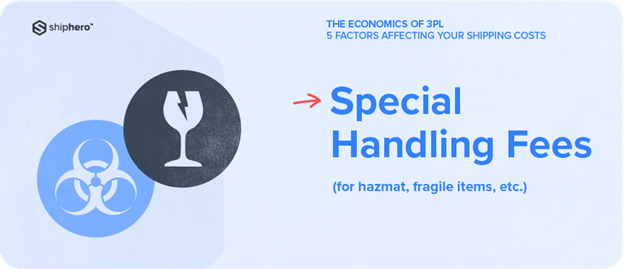
Factor 4 | Special Handling Fees
As a shipper, you’re no stranger to handling fees for hazardous materials and fragile items. But did you know that these fees can have both advantages and disadvantages? Let’s take a closer look at how they can impact your bottom line.
Hazmat
- Revenue Generation: Shippers can generate extra revenue through Special Handling fees, which help cover the expenses of safely transporting fragile or hazardous items. These fees contribute to the overall profitability of the shipping industry.
- Risk Management: To transport hazardous and delicate items safely, shippers should charge special handling fees, conduct inspections, and employ trained personnel. Risk management practices are essential to ensure secure transportation.
- Competitive Advantage: Shipping companies specializing in hazardous and delicate items can become industry leaders by charging extra for their expertise. This draws customers seeking experienced shippers with a deep understanding of complex shipments.
Shipping hazmat and fragile items can be profitable, but shippers must address customer concerns and competition while complying with regulations.
Fragile
When it comes to shipping fragile items, there’s no room for error. After all, damaged items don’t just impact your bottom line – they can also significantly affect your reputation. That’s why taking proactive steps is essential to ensure your items arrive at their destination in one piece. One way to do this is by enlisting the help of your special projects team to assemble kits or pre-assemble your items.
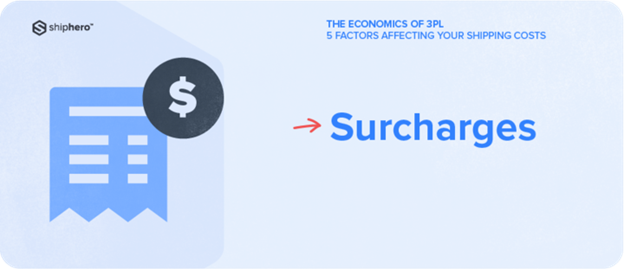
Factor 5 | Surcharges
Surcharges are a necessary evil in shipping and logistics, so they can be the bane of your bottom line if you’re not careful. That’s why it’s essential to be informed and proactive about the different types of surcharges your product lines may encounter.
Navigating outbound shipping can be a complex and costly process for 3PL operators. Negotiating base rates with carriers is just the beginning; understanding accessorial charges and selecting the best base rate based on package specifications is key to mitigating costs. The challenge lies in the surcharges associated with specialized services, which can drive up costs and make it challenging to predict expenditures.
Additionally, general rate increases can significantly impact carrier base rates for 3PLs. However, the right approach and tools can reduce shipping expenses. By utilizing shipping cost strategies, analyzing costs, and planning, surcharges can be minimized.
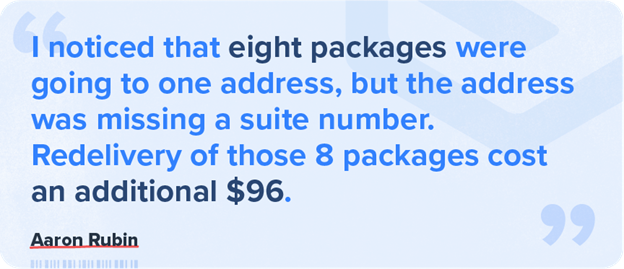
How to Reduce Shipping Charges
Size and Weight
It is important to be mindful of shipping charges, as they can quickly add up and cut into your profits. One way to reduce these costs is by considering the size and weight of your parcels. Oversized boxes or improper packaging can result in higher fees. Look for carriers that offer the correct type of flat-rate shipping or the fees that make the most sense for you and your products.
Additionally, be aware of dim weight pricing (as we discussed at the top of this article), which considers the box’s length, height, and weight. This can sometimes result in extra fees for light packages that take up a significant amount of truck space.
Team Training
Reducing shipping charges is crucial for businesses of all sizes, and optimizing warehouse operations can help achieve this goal. Proper software training is essential to maintain consistency with the packing team and reduce unnecessary costs.
A warehouse management system (WMS) like ShipHero can provide automation that streamlines business operations, but it needs to be used accurately. Your WMS training program should cover all aspects of the hardware and software and the different methods used to manage goods efficiently within the warehouse. By emphasizing the importance of WMS training and implementing consistent warehouse practices, your business can reduce shipping costs and improve overall efficiency.
Equipment
Troubleshooting internal errors such as incorrect scales and improperly stocked packing stations can also enable you to minimize touchpoints and increase automation. With automation rules, packers can always use the appropriate box when shipping specific products. These steps allow you to confidently assert control over your shipping process and save valuable business resources.
Automation
We offer a variety of automation rules to help businesses save money on shipping charges. Our VIP customer treatment rule ensures that your most valuable customers receive a gift SKU or marketing insert with their orders, express shipping, and prioritized order processing. Our pre-sale item rule helps businesses save by setting a partial shipping flag for orders that exceed a specific dollar amount.
Additionally, SKU-specific notes can be assigned to certain items, which is handy for fragile items that require special handling. Finally, we automate box type selections, streamlining the packing process and saving businesses time and money on shipping. With the proper automation rules, businesses can significantly reduce shipping charges and improve their bottom line.
3PL Profitability
To summarize, consider all five critical factors mentioned in this post to reduce your outbound shipping costs: destination and origin, delivery speed, warehouse team processes, special handling fees, and surcharges.
With the right tools and expertise, you can ensure that your 3PL profitability remains reliably on track. And with hard work and dedication to intelligent decisions about outbound shipping strategies—increasing or decreasing delivery speeds or minimizing surcharge risks— you should be more than capable of achieving your goals.
It takes a lot of work, but investing time now to craft an efficient system for managing outbound shipments will pay off down the line. To start managing your outbound shipments efficiently today, try a ShipHero demo and get a jump start on reducing those shipping costs!
Key Takeaways
- Five critical factors affecting shipping costs include weight and zone, delivery speed, warehouse team processes, special handling fees, and surcharges.
- Shipping fees increase as packages move further from their origin, and weight and package dimensions also significantly affect shipping costs.
- Duty relief programs for international shipping, such as Section 321, can save up to 20% on duty fees.
- Last-mile delivery challenges can be solved with partnerships like Veho, which can save money and streamline the process.
- Delivery speed is important for eCommerce businesses, but faster delivery times come with higher costs. Local fulfillment centers and efficient processes can help reduce costs.
- Investing in team training, efficient packing procedures, optimizing picking paths, using automation, and analyzing the correct data can improve warehouse efficiency and reduce costs.
- Hazmat and fragile handling fees can protect businesses from fines and reputation damage, but choosing the proper packaging and labeling is vital.
- Understanding surcharges and negotiating base rates can help mitigate shipping costs for 3PL operators. Planning and analyzing costs can also minimize surcharges.

About ShipHero: We make it simple for you to deliver your eCommerce. Our software helps you run your warehouse, and our outsourced shipping solutions eliminate the hassle of getting your products to your customers. With thousands of brands and 3PLs relying on us daily, we’re here to help with all your logistics needs.
Let us know how we can help you today by scheduling a call HERE.
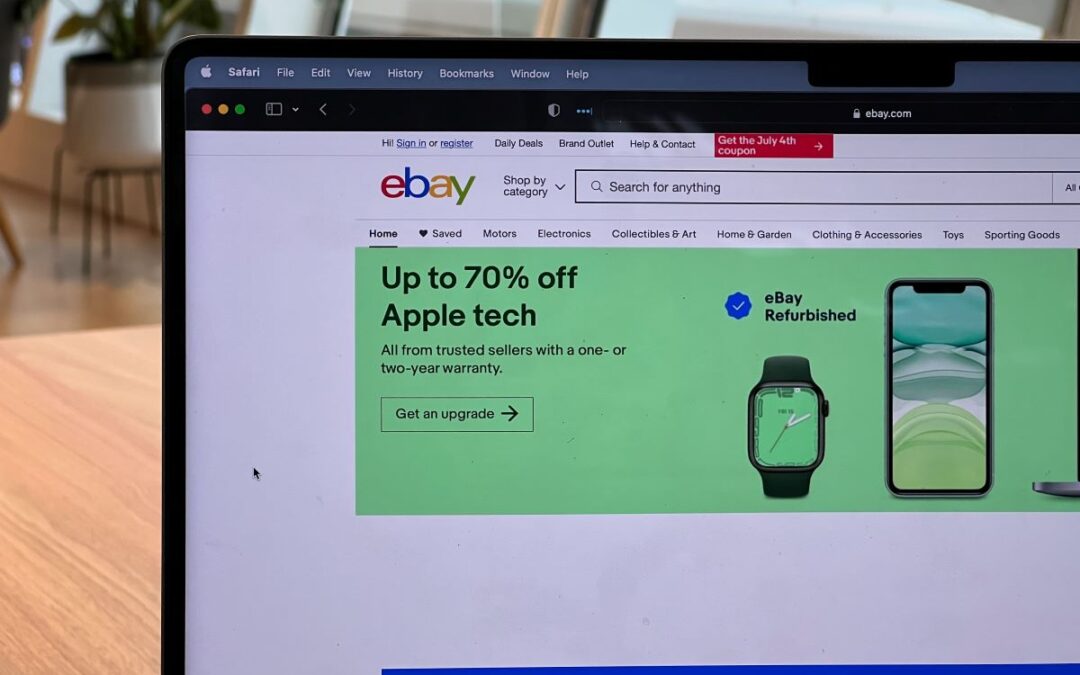
Jul 3, 2023 | Blog
Selling on eBay can be a rewarding experience, but managing inventory and fulfilling orders on your own as your business grows can quickly become overwhelming. That’s where 3PL (Third-Party Logistics) companies come to the rescue! In this blog post, we’ll explore the best 3PL companies for eBay sellers and how to find the right one for you.
What is 3PL?
Let’s start with the basics. 3PL, or Third-Party Logistics, refers to outsourcing your inventory management and order fulfillment to a specialized company. These companies are experts in handling logistics, storage, and shipping, allowing eBay sellers to focus on what they do best: sourcing and selling products!
What is eBay?
eBay is a global online marketplace that connects buyers and sellers, offering a wide range of products from brand new to vintage and collectibles. With millions of active users, eBay provides an excellent platform for entrepreneurs to start and grow their online businesses.
Exploring eBay Fulfillment Services
eBay offers its own fulfillment services, making it easier for sellers to store inventory, process orders, and ship products to customers. By utilizing eBay’s fulfillment services, you can streamline your operations and provide a seamless buying experience. But, as with anything, there are pros and cons to consider.
Benefits and Drawbacks of Using eBay Fulfillment Services
eBay Fulfillment Services offer several benefits, including faster shipping, increased visibility, and simplified returns. However, there are drawbacks too, such as limited storage options and higher costs for certain items. While eBay’s fulfillment services have their merits, many sellers find even greater advantages in partnering with third-party logistics companies. Let’s take a closer look at some of the benefits a 3PL might offer.
The Benefits of Third-Party Fulfillment for eBay Sellers
Time and Energy Saving
Running an eBay business involves various tasks, from sourcing products to managing listings and handling customer inquiries. By outsourcing fulfillment to a 3PL company, you can free up valuable time and focus on growing your business while leaving the logistics to the experts.
Removal of On-hand Inventory Needs
Say goodbye to stuffing your garage or spare room with stacks of products waiting to be shipped. 3PL companies provide secure storage facilities, freeing up your space and eliminating the need for on-hand inventory. This allows you to expand your product offerings without worrying about storage limitations.
Inclusive Shipping Fees
Shipping costs can be a major headache for eBay sellers. With third-party fulfillment, you benefit from discounted shipping rates and simplified fee structures. Many 3PL companies have established partnerships with shipping carriers, ensuring competitive rates and efficient shipping options for your customers.
Handling Multiple Categories
If you sell products across different categories on eBay, juggling inventory and order fulfillment can be challenging. 3PL companies have the expertise to manage multiple product lines efficiently. Whether you sell electronics, fashion, or home goods, they can handle the diverse needs of your inventory and ensure accurate and timely shipments.
Advantages of Outsourcing Your eBay Fulfillment
Scaling Your Business
One of the biggest advantages of outsourcing your eBay fulfillment is the ability to scale your business effortlessly. As your sales volume increases, a 3PL company can quickly adapt to accommodate higher order volumes and provide the necessary infrastructure and resources to handle your growing business. This scalability ensures that you can meet customer demands without experiencing logistical bottlenecks or compromising order fulfillment speed.
Enhancing Your Use of Time
As an eBay seller, your time is valuable. By outsourcing fulfillment, you can redirect your focus towards core business activities that drive growth, such as product research, marketing, and customer engagement. With the burden of order fulfillment lifted off your shoulders, you can allocate your time more effectively, resulting in increased productivity and strategic decision-making.
Evaluating Your Current Staffing and Fulfillment Capacity
Outsourcing fulfillment allows you to reassess your current staffing and fulfillment capacity. Instead of investing in hiring and training additional employees to handle order processing and shipping, you can rely on the expertise of a 3PL company. This not only saves you from the hassle of recruitment and training but also ensures that you have access to experienced professionals who specialize in logistics and fulfillment.
Increasing Flexibility and Revenue
With a 3PL company, you can easily expand into new markets, test new product lines, or experiment with different selling strategies. The ability to adapt quickly to market trends and customer demands can help you seize opportunities and maximize revenue potential. Moreover, by streamlining your operations, reducing overhead costs, and benefiting from cost-effective shipping solutions, outsourcing fulfillment can improve your bottom line
Want to find a 3PL to help you? Here’s where to start…
Top 10 3PL Companies for eBay
Shiphero
ShipHero offers comprehensive 3PL services tailored to eBay sellers, including inventory management, order fulfillment, and shipping solutions. They are a high quality solution dedicated to helping you succeed. Plus, their user-friendly interface and robust integration capabilities make them an ideal partner for eBay sellers of all sizes. They can also help with FBA if you’re using Amazon as a marketplace.
Want to chat with a shipping expert? Click here!
Shipwire
This 3PL has scalable fulfillment solutions with a global presence. Their technology-driven platform and network of warehouses ensure efficient inventory management, order processing, and fast shipping options.
Printful
While primarily focused on print-on-demand services, Printful also provides fulfillment services for eBay sellers. They specialize in custom products, including apparel, accessories, and home decor, offering seamless integration with eBay and high-quality order fulfillment.
Fulfillment by Amazon (FBA)
Although Amazon is a competitor to eBay, utilizing Amazon’s FBA service can still be beneficial for eBay sellers. FBA offers extensive warehousing and fulfillment capabilities, fast shipping options, and access to Amazon’s massive customer base, allowing eBay sellers to reach a wider audience and benefit from Amazon’s logistical expertise.
eFulfillment Service
With over 20 years of experience, eFulfillment Service is a trusted 3PL partner for eBay sellers. They offer a range of services, including storage, order processing, and shipping, with a focus on accuracy and customer satisfaction.
Red Stag Fulfillment
Red Stag Fulfillment specializes in handling large, heavy, or high-value products. They provide secure warehousing, inventory management, and fast order processing, making them an excellent choice for eBay sellers with unique fulfillment needs.
ShipMonk
ShipMonk offers a seamless fulfillment experience for eBay sellers. Their cloud-based platform integrates with eBay, providing real-time inventory management, order processing, and shipping solutions, backed by robust analytics and reporting tools.
Fulfillment Works
Fulfillment Works provides customizable 3PL solutions to eBay sellers. Their services include inventory management, order fulfillment, kitting, and customized packaging options, enabling sellers to create a unique brand experience.
ShipStation
While primarily known as a shipping software, ShipStation also offers fulfillment services through their partner network. Their platform integrates seamlessly with eBay, providing access to multiple 3PL providers and streamlined order management.
ShipCalm
ShipCalm specializes in order fulfillment for small to medium-sized eBay sellers. With their attention to detail and personalized approach, they ensure accurate and efficient order processing, making them a reliable 3PL partner.
Remember, outsourcing eBay fulfillment requires careful consideration to ensure a seamless transition and optimal results for your business. Let’s explore some important factors to keep in mind.
Considerations for Outsourcing eBay Fulfillment
Evaluating Your Inventory Risk
Before outsourcing fulfillment, assess your inventory risk. Consider the value, fragility, and perishability of your products. Determine if the 3PL company has the necessary facilities and expertise to handle your specific inventory requirements, such as temperature-controlled storage or specialized handling.
Assessing Your Warehouse Space Requirements
Evaluate your current and projected warehouse space requirements. Determine if the 3PL provider can accommodate your inventory volume and seasonal fluctuations. Adequate storage space is crucial to ensure the availability of your products and prevent delays in order fulfillment.
Scrutinizing Your eBay Fulfillment Error Rate
Examine your eBay fulfillment error rate. Look for patterns or common issues that lead to errors, such as incorrect packaging or shipping mistakes. Choose a 3PL company with robust quality control measures and a track record of low error rates to minimize order inaccuracies and maintain customer satisfaction.
Calculating Your Fulfillment Costs
Understand your fulfillment costs and compare them to the pricing structures offered by different 3PL companies. Consider factors such as storage fees, pick-and-pack charges, shipping rates, and any additional services you may require. Ensure that the pricing aligns with your budget and that there are no hidden costs that could impact your profitability.
Why Third-Party Fulfillment May Be the Answer to Your eBay Fulfillment Needs
Saving Time on Fulfillment
By outsourcing fulfillment, you can save valuable time spent on order processing, packaging, and shipping. This time can be redirected to other critical business activities, such as product sourcing, marketing, and customer engagement, ultimately helping you grow your eBay business.
Providing Faster and Cheaper Order Delivery
Many 3PL companies have extensive networks and established relationships with shipping carriers, allowing for faster and reduced shipping costs. Leveraging their expertise in logistics and shipping can enhance your customers’ experience by offering quicker delivery times and potentially reducing shipping costs.
Boosting Your Seller Rating
Efficient and accurate order fulfillment contributes to a positive seller rating on eBay. Third-party fulfillment providers specialize in streamlining processes and minimizing errors, leading to improved customer satisfaction and higher seller ratings, which can positively impact your overall eBay performance.
Lowering Your Return Rate
Returns are an inevitable part of eCommerce. However, by partnering with a reliable 3PL provider that employs quality control measures and accurate order fulfillment, you can reduce the likelihood of returns.
Selecting the Right Partner for Your eBay Fulfillment
Criteria for Choosing an eBay Fulfillment Partner
- Experience and expertise in eBay fulfillment
- Integration capabilities with eBay’s platform
- Service offerings that align with your business needs
- Scalability to accommodate your growth
- Reliable and efficient order processing and shipping capabilities
- Clear pricing structure with no hidden fees
- Strong customer support and communication channels
Finding the Best eBay Fulfillment Company for Your Business
To find the best eBay fulfillment company, conduct thorough research, read reviews, and seek recommendations from other eBay sellers. Request quotes and compare services, capabilities, and pricing. Your 3PL should have your success in mind, choose a partner that not only meets your requirements but also shares your commitment to quality and customer satisfaction.
Key Takeaways
Outsourcing eBay fulfillment to a trusted 3PL company can be a game-changer for your business. By evaluating your needs, considering the benefits, and selecting the right partner, you can streamline your operations, save time, provide faster shipping, boost your seller rating, and lower return rates. So, why stress over logistics when you can let the experts handle it? Take the leap, partner with a top-notch 3PL company, and watch your eBay business soar to new heights of efficiency and profitability.

Frequently Asked Questions
Does eBay Use 3PL?
Yes, eBay offers its own fulfillment services called eBay Fulfillment, which can be considered a form of 3PL. However, eBay also allows sellers to use third-party 3PL companies for their fulfillment needs if they prefer.
What Delivery Service Does eBay Use?
eBay does not have a single designated delivery service. The choice of delivery service depends on various factors such as the seller’s location, the buyer’s location, the shipping method selected by the seller, and the shipping services available in the respective regions.
Can I Use FBA to Fulfill eBay Orders?
eBay and Amazon are separate marketplaces with different fulfillment systems and policies. However, some sellers may choose to use FBA for their eBay orders as a workaround. It’s important to note that using FBA for eBay orders may have limitations and may not provide seamless integration or dedicated customer support from eBay.
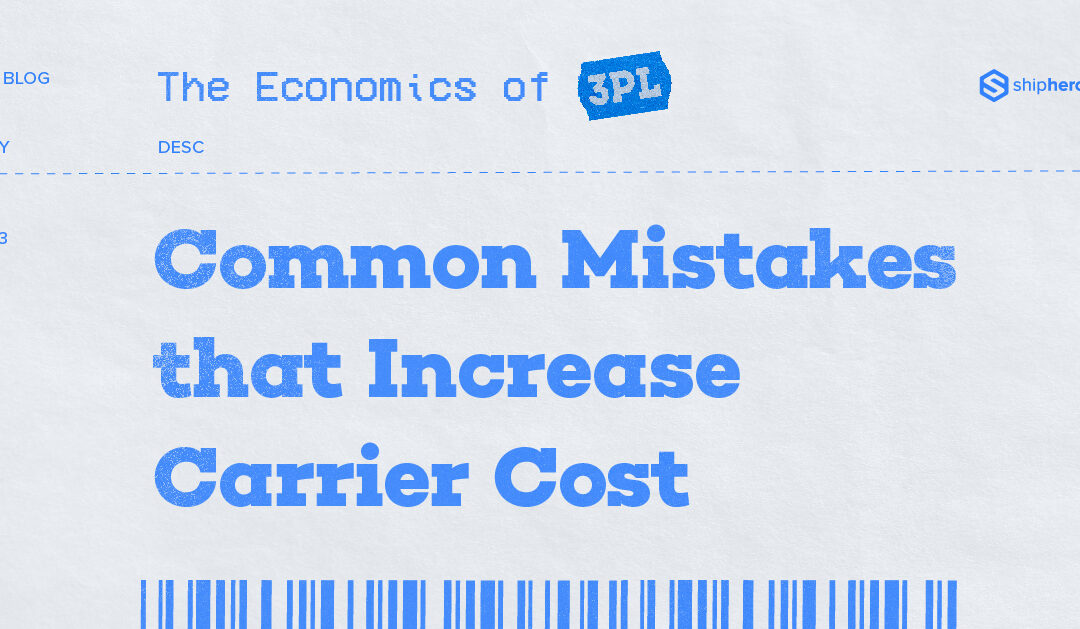
Jul 28, 2023 | 3PL Warehouse Management, Blog, Economics of 3PL, Fulfillment
Shipping costs can quickly add up and devour your budget, but it doesn’t have to be this way. The trick is to avoid common pitfalls that lead to inefficient processes and additional charges. In this post, we’ll explore some common mistakes that should be avoided at all costs to save money on fulfillment – equipping you with the know-how needed for sound business decisions moving forward.
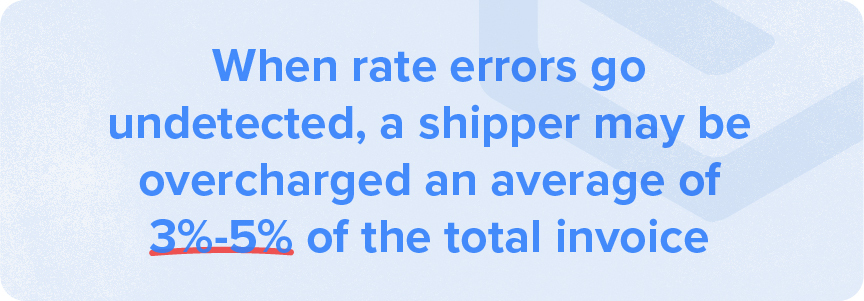
Invoice Errors
Did you know that 5% of invoices contain errors and inaccuracies? The root causes of these mistakes are often common shipping issues like accessorials and late fees. When rate errors go undetected, a shipper may be overcharged an average of 3%-5% of the total invoice.
For example, if you look at the FedEx Invoice below, the total charges are $1,831.17. If 5% of those charges are riddled with inaccuracy, then you’d be paying $92 in unnecessary overages – which adds up.
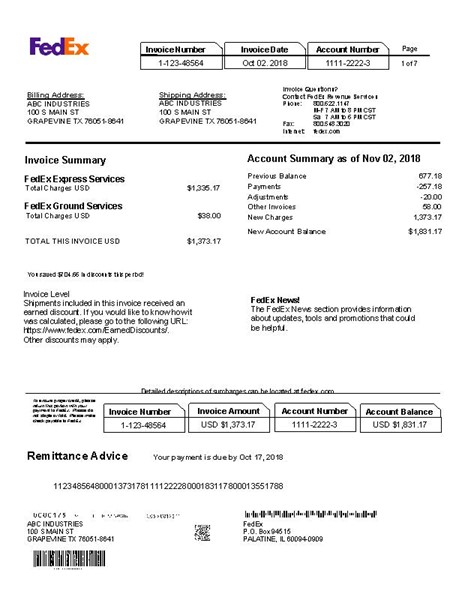
Accessorial Charges
These costs are not always clear-cut and can fluctuate depending on the carrier. Our in-depth article on accessorial charges outlined three key lessons businesses can use to minimize mistakes and unexpected fees.
- Know all your costs, even the hidden ones, and ask about accessorial fees upfront.
- Analyze your shipping invoices regularly to catch any billing mistakes early.
- Plan ahead for peak surcharges to save your business significant money on shipping costs.
See more details in our guide to managing accessorial charges.
Late Fees
Inefficient systems can often delay the clearing of invoices, which results in unnecessary late fees. For example, both UPS and FedEx have instituted late payment fees. To avoid incurring these fees, make sure that payment is received by UPS within 14 days of the invoice due date and for FedEx, within 15 days of the invoice date. If payment is not received by the due date, both carriers charge a late payment fee of 6% of the total past-due balance. FedEx places delinquent accounts on cash-only status, which could cause delays in your shipments and the loss of applicable discounts.
Shipping companies are responsible for ensuring an effective system to avoid late charges and penalties. Failure to meet the terms of the agreement can also result in carriers charging additional interest fees.
Know Where Your Charges Are Coming From
When a shipper hires a transportation company to move their goods, an invoice or bill is created for each job. These documents contain important information about the shipment, the services provided, and any additional services rendered. For carriers, it compiles all charges from every Bill of Lading associated with the shipment.
Your Bill of Lading Should Include the Following:
- Purchase order or account number
- Shipment date
- Shipper’s name and address
- Recipient’s name and address
- Number of units being shipped
- Description of what’s being shipped
- Declared value of goods being shipped
- Shipment packaging – cartons, crates, pallets, etc.
- A notation if the product in the shipment is hazardous
- Exact shipment weight
- Pickup or delivery specifications

Common Shipping Errors
Shipping errors are an unfortunate reality in the fulfillment industry. Every 3PL wants to ensure a seamless pick, pack, and ship process, but mistakes can and do happen. It’s important to be vigilant and watch for common errors.
Incorrect Measurements, Dimensions, and Packaging
Small mistakes in measurements, dimensions, and packaging can lead to expensive surcharges for shipping. Even slight errors can cause significant charges to accumulate. It’s important to remember that shipping fees are calculated based on the greater value of weight or size, which means DIM weight can also affect shipping fees. Measuring and weighing packages accurately is crucial to avoid these unnecessary expenses.
Measurements and Dimensions
UPS, for example, if your package dimensions don’t match your labels, the mislabeled packages will be subject to a shipping correction fee. If you get charged with a shipping charge correction audit fee, you’ll have to pay the greater of the following:
- $1.00 per mislabelled package during the applicable invoice period; or
- 6% of the total shipping charge corrections during that invoice period
So, invest in a reliable scale and WMS to avoid incorrect estimates and unnecessary fees. This will ensure your measurements match your carrier’s, reducing the risk of unexpected charges. Giving incorrect delivery details might seem insignificant, but it can quickly snowball into a logistical nightmare.
Packaging
Rather than trying to save money by using cheap materials or skimping on protective measures, investing in better packaging will ultimately save you money in the long run by reducing re-shipping fees caused by transit damage.
Keep packages as small as possible and minimize inserts to minimize your costs further. Standardizing packaging is also important in reducing costs, helping you to streamline the process and minimize materials. Following these tips can significantly reduce your packaging costs without compromising quality. With so much at stake, taking shipping accuracy seriously is essential.
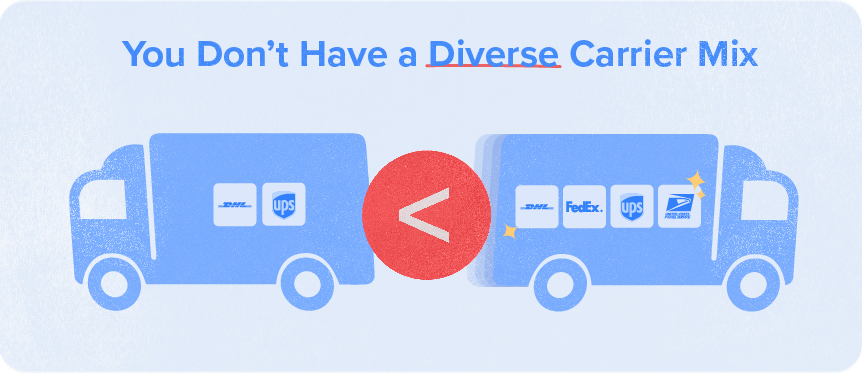
You Don’t Have a Diverse Carrier Mix
To avoid high shipping costs, diversify your carrier mix. Relying solely on one carrier may leave you vulnerable if they face capacity issues, raise prices, or go out of business. Without other options, you may have to pay expensive fees to ship your goods.
Why You Need a Multi-Carrier Platform
Cost Effective: To save on shipping costs, choose carriers that fit your budget and take advantage of available deals and discounts. Comparing rates on a single platform is easy and helps you make informed decisions. Let the software do the work for you.
Saves Time: Input package details into your WMS and let technology compare rates from various carriers. You’ll have diverse shipping options to select the most affordable and efficient.
Reduces Disruptions: Using a multi-carrier platform can prevent shipping delays by seamlessly switching to another carrier if one experiences trouble.
Handling Unique Scenarios: When you use multiple carriers, it’s possible to choose a more affordable option for free shipping and give customers the choice to upgrade for faster delivery times.
Not Using a WMS
When managing logistics operations, using a warehouse management system is not just a nice-to-have; it’s a must. Manually determining the cheapest rate based on address, weight/dimensions, and shipping speed is tedious and complex. Not to mention the risk of shipping errors and lost time.
With ShipHero’s Rate Shopping, you can access the most up-to-the-minute shipping rates from major carriers. Buy the label at the cheapest price. It’s time to take advantage of a WMS.
Utilize Technology and Automation
A WMS is not just about the convenience of having everything in one place – but the benefits of automation. By reducing the need for personnel in the shipping process, companies can save money, reduce processing time, and improve accuracy. With fewer jobs for staff, there’s also less risk of data entry errors and lower costs because you need less help to run your 3PL.
By utilizing warehouse management software, you can accomplish the following:
- Combine and streamline shipments to improve shipping efficiency.
- Reduce mistakes to cut shipping costs significantly.
- Access to numerous carriers and compare prices to find the most affordable option.
- A single dashboard provides complete visibility of all your shipments.
- Ensure real-time updates on shipment status for your customers.
- Improve service levels and reduce customer churn to achieve customer satisfaction.
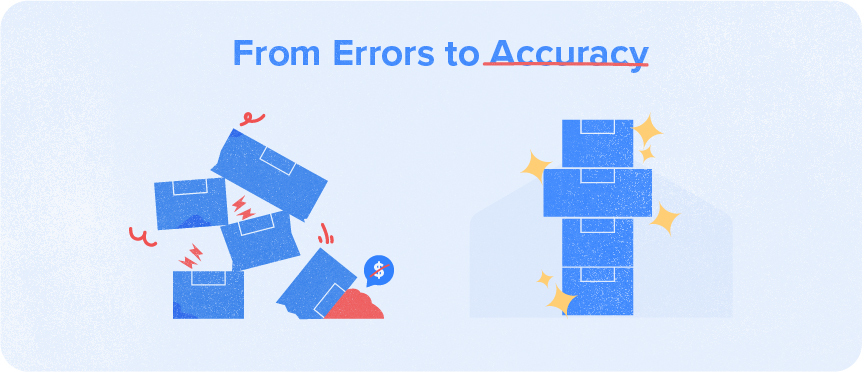
From Errors to Accuracy
To manage carrier costs accurately, it’s essential to take the time to verify that invoices are correct and up-to-date and ensure that your fulfillment systems are processing payments promptly. It’s also important to consider the non-monetary shipping costs, including accurate measurements, dimensions, and packaging. This can help you avoid costly surcharges and ensure your deliveries are successful. Finally, implementing a warehouse management system can save you time, prevent shipping delays, compare prices, and reduce errors.
Key Takeaways:
- Inaccurate invoices can result in overcharges of 3%-5% of total invoice values.
- Auditing invoices thoroughly and double-checking for accuracy is important to avoid invoice errors.
- In-depth knowledge of accessorial charges can minimize mistakes and unexpected fees.
- Efficient fulfillment systems are necessary to avoid late fees and interest charges.
- Avoid costly overcharges by ensuring accurate and timely payment of carrier bills.
- Accurate measurements, dimensions, and packaging are crucial to avoid expensive surcharges.
- Diversifying carrier mix can prevent shipping delays and expensive fees.
- Using a warehouse management system can save time, reduce errors, and compare prices.

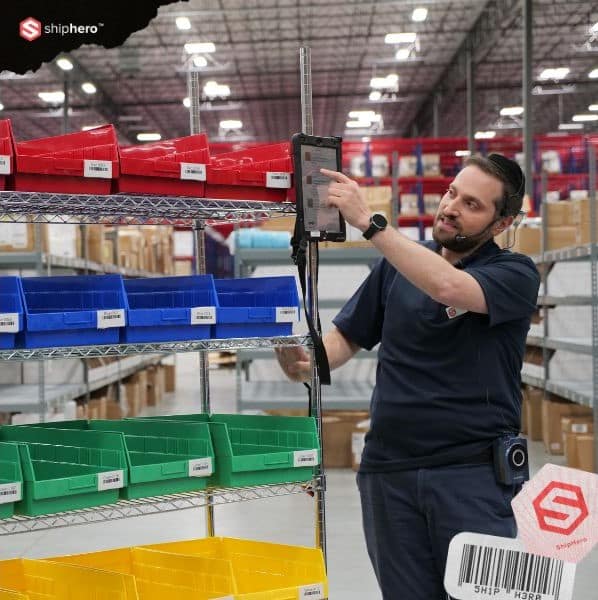
Apr 2, 2024 | 3PL Warehouse Management, Article, Warehouse Management Software
A 3PL Warehouse Management System (WMS) is a software solution that helps companies manage and optimize their warehouse operations. It provides a centralized platform for handling tasks such as inventory management, order fulfillment, shipping, and receiving.
What is the 3PL Warehouse Management System?
It’s an essential tool for third-party logistics providers that lets them efficiently manage their clients’ warehouse operations.
A key challenge third-party logistics providers face is managing the vast amount of inventory stored in their warehouses. The 3PL Warehouse Management System addresses this challenge by providing a comprehensive set of tools and functionalities to effectively manage and control warehouse operations.
At its core, the 3PL WMS is a software application that integrates with the existing warehouse infrastructure and automates various processes like inventory management, order fulfillment, and shipping. It provides real-time visibility into inventory levels. And it helps logistics providers optimize storage space and ensure accurate stock levels.
Moreover, the 3PL WMS enables efficient order processing by automating tasks like order picking, packing, and labeling. It provides warehouse staff with detailed instructions on how to fulfill each order, and this minimizes errors while improving overall productivity.
Another key feature of the 3PL WMS is its ability to track and trace goods throughout the warehouse. By using barcode scanning or RFID technology, the system can accurately track the movement of inventory from the moment it arrives at the warehouse to the moment it leaves for delivery.
Furthermore, the 3PL WMS offers advanced reporting and analytics capabilities. They can generate reports on key performance indicators like order accuracy, on-time delivery, and inventory turnover. This helps businesses identify areas for improvement.
In addition to these core functionalities, the 3PL WMS can be customized to meet the specific needs of different industries and clients. For example, it can support temperature-controlled storage for perishable goods or provide specialized picking algorithms for eCommerce fulfillment.
In conclusion, the 3PL Warehouse Management System is a powerful tool that enables third-party logistics providers to efficiently manage their clients’ warehouse operations. By automating key processes and providing real-time visibility into inventory, the system helps improve productivity, accuracy, and customer satisfaction. It’s an indispensable asset for logistics providers in today’s complex and competitive business environment.
To further understand the scope and benefits of third-party logistics, explore our detailed guide on 3PL services, which highlights how these services streamline operations and enhance efficiency.
Benefits of 3PL Warehouse Management Systems
Implementing a 3PL Warehouse Management System can bring numerous benefits to a company.
Firstly, it provides real-time visibility into stock levels and locations to reduce the risk of stockouts and minimize excess inventory.
Secondly, a 3PL WMS improves order fulfillment efficiency by automating processes like order picking and packing. This leads to faster order processing times and improved customer satisfaction.
Additionally, a 3PL Warehouse Management System lets companies optimize their warehouse space utilization. By providing insights into optimal storage locations and recommending efficient picking routes, it maximizes the storage capacity and minimizes unnecessary movement.
Lastly, a 3PL WMS enhances supply chain visibility by providing real-time tracking and reporting tools. This lets companies monitor the flow of goods, identify bottlenecks, and make data-driven decisions to improve overall efficiency.
Ecommerce businesses require specialized inventory management solutions to meet the dynamic demands of online retail. Learn more about ecommerce inventory management software that complements 3PL WMS for seamless integration and enhanced efficiency.
Key Features of 3PL Warehouse Management Systems
A good 3PL Warehouse Management System offers a range of features to support warehouse operations. These features include:
- Inventory tracking and management
- Order management and fulfillment
- Picking and packing optimization
- Automated labeling and barcode scanning
- Real-time reporting and analytics
- Integration with other supply chain systems
Choosing the right inventory management software is crucial for optimizing warehouse operations. Discover the best inventory management software options that can seamlessly integrate with 3PL WMS to provide comprehensive inventory control.
What are 3PL WMS Requirements?
When considering a 3PL Warehouse Management System, it’s important to assess the specific requirements of your business. Some key considerations include:
- Scalability: Is the system able to handle your current needs and accommodate future growth?
- Integration: Can the 3PL WMS seamlessly integrate with your existing software and systems?
- User-friendly interface: Is the system intuitive and easy for your staff to navigate?
- Flexibility: Does the system support customizable workflows and configurations?
- Support and training: Does the vendor offer adequate support and training resources?
Real-time Visibility & Reporting Tools
A key advantage of a 3PL Warehouse Management System is real-time visibility into warehouse operations.
Companies can access up-to-date information on inventory levels, order statuses, and overall performance at any time so businesses can quickly identify and address bottlenecks.
Implementing a 3PL Warehouse Management System
Following these steps will help you carefully plan and integrate a 3PL Warehouse Management System:
- Assess your current warehouse processes and identify areas for improvement.
- Research and select a suitable 3PL WMS solution based on your business requirements.
- Collaborate with the vendor to customize the system according to your specific needs.
- Train your staff on how to effectively use the new 3PL WMS.
- Gradually transition operations to the new system, ensuring minimal disruption to day-to-day activities.
- Regularly assess the system’s performance and make necessary adjustments as your business evolves.
Things to Look for When Choosing 3PL WMS Software
When choosing a 3PL Warehouse Management System, it’s important to consider the following factors:
- Usability: Ensure the system has an intuitive interface that can be easily navigated by your staff.
- Scalability: Choose a system that can accommodate your current needs while also allowing for future growth.
- Integration: Check if the 3PL WMS can seamlessly integrate with your existing software and systems.
- Customizability: Assess whether the system allows for customizable workflows and configurations to suit your business processes.
- Vendor Support: Research the vendor’s reputation and availability of support resources.
How much does a 3PL WMS Cost?
The cost of a 3PL Warehouse Management System can vary depending on factors like the size of your business, the features you want, and the vendor you choose. Some vendors offer pricing models based on the number of users or the volume of goods processed. Request quotes from different vendors and consider the long-term ROI when evaluating the cost of a 3PL WMS.
Key Takeaways
- Improves Efficiency and Accuracy: A 3PL WMS automates various warehouse processes such as inventory management, order fulfillment, picking, packing, and shipping, leading to improved efficiency, minimized errors, and enhanced productivity. This contributes to faster order processing times and heightened customer satisfaction.
- Enhances Visibility and Optimization: The system offers real-time visibility into inventory levels and warehouse operations, enabling companies to reduce the risk of stockouts, minimize excess inventory, and optimize warehouse space utilization. This visibility also facilitates data-driven decisions to improve overall efficiency and effectiveness.
- Customizable and Scalable: A 3PL WMS can be tailored to meet the specific needs of different industries and clients, including features like temperature-controlled storage for perishable goods or specialized picking algorithms for eCommerce fulfillment. It’s designed to accommodate current needs and scale with the business as it grows.

Frequently Asked Questions
What is the role of a 3PL Warehouse Management System?
A 3PL WMS helps companies manage and optimize warehouse operations, including inventory management, order fulfillment, and reporting.
How can a 3PL WMS benefit a company?
A 3PL Warehouse Management System can improve inventory accuracy, order fulfillment efficiency, warehouse space utilization, and supply chain visibility.
What features should I look for in a 3PL WMS?
Key features include inventory tracking and management, order management, picking and packing optimization, real-time reporting tools, and system integration capabilities.
How much does a 3PL WMS cost?
The cost varies depending on factors like the size of the business, desired features, and the vendor chosen. It’s important to request quotes and consider long-term ROI.




























